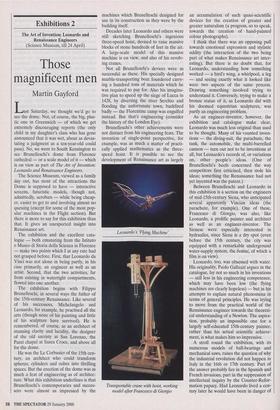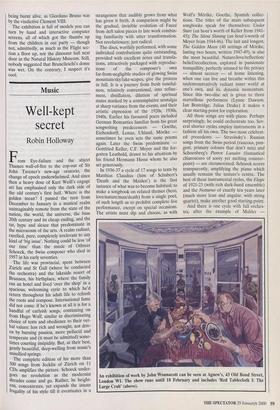Exhibitions 2
The Art of Invention: Leonardo and Renaissance Engineers (Science Museum, till 24 April)
Those magnificent men
Martin Gayford
Last Saturday, we thought we'd go to see the dome. Not, of course, the big, plas- tic one in Greenwich — of which we get extremely discouraging reports (the only child in my daughter's class who has gone announced that it was wet, about as devas- tating a judgment as a ten-year-old could pass). No, we went to South Kensington to see Brunelleschi's dome from Florence cathedral — or a scale model of it — which is on view as part of The Art of Invention: Leonardo and Renaissance Engineers.
The Science Museum, viewed as a family day out, has most of the attractions the Dome is supposed to have — interactive screens, futuristic models, though not, admittedly, acrobats — while being cheap- er, easier to get to and involving almost no queuing (except for some of the most pop- ular machines in the Flight section). But there is more to say for this exhibition than that. It gives an unexpected insight into • Renaissance art.
The exhibition and the excellent cata- logue — both emanating from the Istituto e Museo di Storia della Scienza in Florence — make two points which I at any rate had not grasped before. First, that Leonardo da Vinci was not alone in being partly, in his case primarily, an engineer as well as an artist. Second, that the two activities, far from existing in watertight compartments, flowed into one another.
The exhibition begins with Filippo Brunelleschi, in several ways the father of the 15th-century Renaissance. Like several of his successors, Michelangelo and Leonardo, for example, he practised all the arts (though none of his painting and little of his sculpture have survived). He is remembered, of course, as an architect of stunning clarity and lucidity, the designer of the old sacristy at San Lorenzo, the Pazzi chapel at Santa Croce, and above all for the dome.
He was the Le Corbusier of the 15th cen- tury, an architect who could transform spheres, cylinders and cubes into thrilling spaces. But the erection of the dome was as much a feat of engineering as of architec- ture. What this exhibition underlines is that Brunelleschi's contemporaries and succes- sors were almost as impressed by the machines which Brunelleschi designed for use in its construction as they were by the building itself.
Decades later Leonardo and others were still sketching Brunelleschi's ingenious three-speed hoist, devised to raise massive blocks of stone hundreds of feet in the air. A large-scale model of this massive machine is on view, and also of his revolv- ing cranes.
Not all Brunelleschi's devices were as successful as these. His specially designed marble-transporting boat foundered carry- ing a hundred tons of materials which he was required to pay for. Also his imagina- tive plan to speed up the siege of Lucca in 1428, by diverting the river Serchio and flooding the unfortunate town, backfired badly — the Florentine camp was engulfed instead. But that's engineering (consider the history of the London Eye).
Brunelleschi's other achievements were not distinct from his engineering feats. The invention of single-point perspective, for example, was as much a matter of practi- cally applied mathematics as the three- speed hoist. It is possible to see the development of Renaissance art as largely Leonardo's 'Flying Machine' Transportable crane with hoist, working model after Francesco di Giorgio an accumulation of such quasi-scientific devices for the creation of greater and greater naturalism (a progress, so to speak, towards the creation of hand-painted colour photographs).
I think that there was an opposing pull towards emotional expression and stylistic oddity (the interaction of the two being part of what makes Renaissance art inter- esting). But there is no doubt that, for Leonardo, understanding how something worked — a bird's wing, a whirlpool, a leg — and seeing exactly what it looked like were two aspects of the same process. Drawing something involved trying to understand it. Conversely, trying to make a bronze statue of it, as Leonardo did with his doomed equestrian sculptures, was partly an engineering problem.
As an engineer-inventor, however, the exhibition and catalogue make clear, Leonardo was much less original than used to be thought. Many of his vaunted inven- tions — the diving-suit, the parachute, the tank, the automobile, the multi-barrelled cannon — turn out not to be inventions at all, but Leonardo's records of, or variations on, other people's ideas. (One of Brunelleschi's beefs concerned the way competitors first criticised, then stole his ideas; something the Renaissance had not yet inyented was the patent.) Between Brunelleschi and Leonardo in this exhibition is a section on the engineers of mid-15th-century Siena, who anticipated several apparently Vincian ideas (the parachute, for example). One of these, Francesco di Giorgio, was also, like Leonardo, a prolific painter and architect as well as an engineer-inventor. The Sienese were especially interested in hydraulics, since Siena is a dry spot (even before the 15th century, the city was equipped with a remarkable underground water-supply system, the bottini, of which a film is on view).
Leonardo, too, was obsessed with water. His originality, Paolo Galluzzi argues in the catalogue, lay not so much in his inventions — still less in his engineering competence, which may have been low (the flying machines are clearly hopeless) — but in his attempts to explain natural phenomena in terms of general principles. He was trying to move from the practical world of the Renaissance engineer towards the theoreti- cal understanding of a Newton. The aspira- tion, probably an impossible one for a largely self-educated 15th-century painter, rather than his actual scientific achieve- ment, is what makes him so impressive.
A stroll round the exhibition, with its numerous models of ball-bearings and mechanical saws, raises the question of why the industrial revolution did not happen in Italy in the 16th or 17th century. Part of the answer probably lies in the Spanish and French invasions, part in the suppression of intellectual inquiry by the Counter-Refor- mation papacy. Had Leonardo lived a cen- tury later he would have been in danger of being burnt alive, as Giordano Bruno was by the vindictive Clement VIII.
The exhibition is full of models you can turn by hand and interactive computer screens, all of which got the thumbs up from the children in our party — though not, admittedly, as much as the Flight sec- tion a floor up, nor the dinosaur hall next door in the Natural History Museum. Still, nobody suggested that Brunelleschi's dome was wet. On the contrary, I suspect it's cool.



















































































 Previous page
Previous page